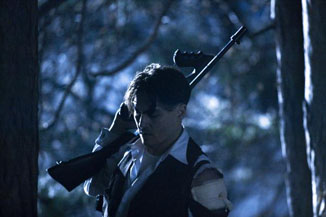Book vs. Movie: Public Enemies
By Russ Bickerstaff
July 8, 2009
The bulk of the interpersonal detail in the book rests squarely on the lives of the criminals the FBI was chasing after. From the Barker-Karpis gang to John Dillinger to Machine Gun Kelly to Bonnie and Clyde to Baby Face Nelson, Burrough has done a great deal of research into the personal lives of some of the 1930s' most notorious criminals. Where dialogue is sited, it had specifically been related by credible sources or, in some cases, FBI transcripts from actual telephone dialogues between the criminals and their associates. Rather than focus on each criminal individually, Burrough delivers the story chronologically in clear, crisp narrative prose. As a result, the narrative jumps around a bit. We're in Texas with Bonnie and Clyde, Then we're in Wisconsin with Dillinger, then we're vacationing in Reno with Barker-Karpis...and the detailed accounts of actual bank robberies get a bit repetitious, but this is a thoroughly enjoyable excursion into an era when bank robbers could be heroes perilously conscious of their own public images.
The repetition of the bank robberies and hideouts and stakeouts can sort of blur together after a while, but these moments are excused by some of the less-explored angles on the lives of these people. Of particular note here is the support personnel. A seedy lawyer used a female warden's pride against her in manipulating her to keep a captured Dillinger in a jail in Indiana that he would be able to escape from as opposed to a maximum security facility that would've probably taken him straight to his execution. Then there was the black market plastic surgeon who was highly paid to do identity-altering facelifts and fingerprint removals. The fingerprint operations sounded particularly grizzly — involving drugs taken to numb pain, a knife and a pencil-sharpening-like operation to flake away telltale distinguishing features in the fingers. Dillinger's obsession with plastic surgery was particularly fascinating. He spent a lot of money getting his face altered. So happy was he with the effect that he became confident and regularly went out in public to baseball games and movies and such. These relatively uncovered angles lend Public Enemies a fascinating perspective on the people involved in the birth of a very influential government agency.
The Movie
Chicago-born Michael Mann (Collateral, Miami Vice) has elected to focus two hours of film exclusively on the Dillinger that had been portrayed in Burrough's book. This makes sense, as Bonnie and Clyde had already been covered in great depth in a highly successful film some years ago and none of the rest of the FBI's first targets had the kind of legendary status that Dillinger enjoyed. Theoretically, if this one was hugely successful, Mann could go back and do sequels focusing on each of the other criminals explored in Burrough's book, but it seems unlikely.
The story begins as Dillinger (Johnny Depp) has been taken into custody. He's about to escape. Mann is focusing on the final days of Dillinger in some pretty vivid detail. Chasing him down is Christian Bale in the role of Melvin Purvis, the agent Hoover (Billy Crudup) has put in charge of tracking him down.
Continued:
1
2
3




